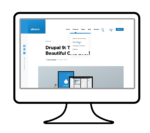One percent of the world’s websites may sound like a small number, but when the Drupal content management system hosted DrupalCon, its first users conference in San Francisco last month, it became clear that the open-source framework isn’t a niche project. According to the project’s creator, Dries Buytaert, 1% of the world’s websites now use the PHP-based system.
Drupal users include some high-profile websites. The White House announced, during the conference, that it will contribute modified Drupal code used on whitehouse.gov. It marks the first time a U.S. president’s IT team has ever contributed back to an open-source project.
Buytaert created Drupal in 2001 as a Web-based message board. The name comes from the Dutch word for “drop,” the original name of the site where he hosted the fledgling Drupal code. He went on to found a company, Acquia, based around offering service, support and training for Drupal users.
At DrupalCon, Acquia and Rackspace announced a partnership to promote the use of Drupal inside Rackspace’s hosting and cloud environments.
“The traction that Drupal has made in the enterprise market has been tremendous, and joining forces with Acquia to extend our offering to the Drupal customers we already support was a natural fit,” said John Engates, Rackspace’s CTO.
Even Microsoft was on hand to promote and discuss Drupal. The company sponsored DrupalCon, and at the show, it announced the release of SQL Server Driver for PHP 2.0. The new driver is intended to make it easier for developers using Drupal to build sites that use SQL Server by adding support for storing PHP data objects in SQL Server.
While actual usage numbers are somewhat difficult to come by, the Drupal website does track the number of update requests it receives from installed Drupal servers around the world. While that number is not directly tied to the number of Drupal users worldwide, it shows Drupal’s acceptance by enterprises and businesses.
Those statistics show usage of Drupal 6, which is not the newest version, grew from 50,000 active sites in July 2008 to more than 300,000 sites in January 2010. The project claims more than 8,000 contributors.





